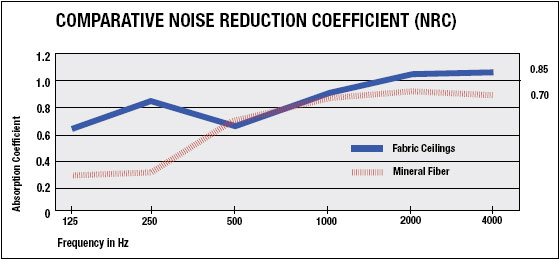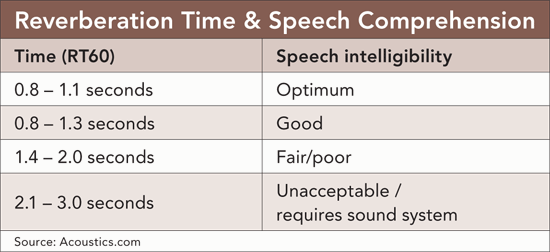Ceiling Technology and Aesthetics
Luminous reflectance factor is often conflated with the measure light reflectance value, or LRV. Yet LRF and LRV are distinct measures: LRF can be described as “the color contrast between two material surfaces,” while the LRV quantifies how much light is reflected; if less light is reflected, the LRV will be lower. Color and texture have an important effect on LRV.
Renewed Focus on Acoustics
Whether colored or white, flat or shaped, the ceiling surface is important for integrating various building functions including illumination, acoustics, comfort, and other environmental controls.
Arguably the most valuable contribution of the modern hung ceiling has been in acoustical performance, often in settings where walls and floors are hard and impermeable. “Ceiling tile is good for sound attenuation, and on a case-by-case basis a buffer can be added on top of the ceiling grid and tiles for additional attenuation,” says WDG's Isogai. “We have to be careful with drywall ceilings; they can bounce sound back, although curved shapes can mitigate this. But if we are considering drywall ceiling for an area with stone, tile or similar finishes on the walls and floors, we have to be careful.”
 |
Different materials have varying noise reduction coefficient (NRC) values over a range of noise frequencies. A fabric ceiling panel (blue line) is compared to a mineral fiber material. Image courtesy of Hunter Douglas Contract |
Ceiling tile materials used have included porous blends of pressed cellulose, cork, mineral wool, clay, perlite, and starch, as well as foam backings and other soft acoustical mats of natural and synthetic substances. The products absorb noise but may also attract or retain moisture, and tiles or sections must be replaced once wetted by errant HVAC condensation, for example. However, they offer good acoustical performance, which is increasingly valuable for building design.
Noise levels in commercial and institutional buildings have been trending upward, according to acousticians and public health experts. The acoustical environment is a sum of several factors:
- Direct sound—for example, the path from a speaker to a listener.
- Reflected sound—which travels from the source and off interior surfaces and then to the recipient.
- Reverberation—or the persistence reflected sound, often quantified as reverberation time to describe how long it takes for reflected sound to become unintelligible.
- Background noise—generally includes undesired ambient noise sources indoors, such as mechanical system sounds, as well as outdoors.
 |
The resilient floors and painted walls of concrete block in typical U.S. school classrooms, for example, often contribute to long reverberation times for very poor acoustics, limiting speech intelligibility by 25 percent or more, according to a seminal University of Kansas study.
In hospitals, where speech intelligibility can be a matter of life or death, interior noise levels have been increasing by about 4.0 decibels every decade over the last 50 years, a Johns Hopkins study5 concluded in 2005. Average sound levels in some healthcare environments are greater than that for conversational speech—about 50 decibels (dBA)—due to longer reverberation times and HVAC system background noise.
With these challenges in mind, acoustics are drawing increasing scrutiny in healthy, sustainable building design. Credit for effective sound isolation, acoustical finishes, and room noise are codified in standards such as U.S. Green Building Council's LEED certification programs for education and healthcare facilities. The baseline performance in LEED for Schools is drawn from the American National Standards Institute (ANSI) Classroom Acoustics Standard, ANSI S12.60. In LEED for Healthcare, the reference standards include Guidelines for Design and Construction of Health Care Facilities, authored by the Facility Guidelines Institute/American Society for Healthcare Engineering (FGI/ASHE). Acoustical consultants see the green building standards as a minimum performance threshold, however.
For acoustical finishes such as the ceiling system, the basic variables for performance include the noise reduction coefficient (NRC), which describes how much sound energy is absorbed by a surface. NRC values range from 0 (perfect reflection) to 1 (perfect absorption); for ceiling acoustics, higher values are better. A similar measure is sound absorption average or SAA, which is calculated over a wide range of frequencies from 100 hertz to 500 hertz; this broadband average is valuable as an accurate measure of the total sound absorption characteristics of a ceiling panel.
A third measure of use to architects is sound transmission class, or STC, which describes how well a building assembly attenuates airborne sound. The ASTM method for calculating STC has changed considerably over the decades. An STC of 25 means that normal speech can be easily heard through the partition or floor-ceiling assembly; an STC of 50 or 60 provides very good to superior soundproofing.
Last, the measure CAC or ceiling attenuation class is an acoustical rating specifically designed for ceiling materials, to describe room-to-room sound transmission in a commercial setting. Because interior partitions in commercial buildings often do not extend to the roof deck or floor decks, noise can travel over interior walls through the open plenum; ceiling systems with high CAC numbers are designed to prevent this.
For this reason, ceilings often need to be both an acoustical absorber (to reduce reverberation) and an acoustical barrier (to block noise). So the choice of a suspended ceiling tile material—and backers, in some cases—is likely to be a carefully orchestrated compromise. Ceiling materials or systems must offer a high NRC of more than 0.5, and new products and systems now offer very good acoustical performance, which NRC and SAA values of 0.85 to 0.90 and better.
Tested NRC and STC ratings are part of the equation, but the architecture and engineering team must consider more than the acoustical properties of different materials and systems; it is also important to know how sound is transmitted, and where it is suitable to use particular sound-isolating or insulating materials or assemblies.
Specifying High-Performance Ceilings
In addition to acoustical performance, the considerations for selecting and specifying ceiling assemblies include durability, toxicity, recycled content, and luminous reflectance, which is impacted by color and physical texture. The luminous reflectance levels of all interior surfaces—including ceiling assemblies —are considered together to estimate the level of illumination in the space. Other key considerations for selecting and specifying ceiling assemblies include:
Acoustics. As described earlier, this important element of IEQ is impacted substantially by ceiling choice. Acoustical ratings inform the design solution, with NRC values near 0.85 and an SAA of 0.89 providing a good performance benchmark.
Fire performance. The contribution of ceiling systems to smoke development and flame spread is vital to occupant safety. Selected materials should meet Class A requirements per the standard ASTM E84 for surface burning, with flame spread values below 25 and smoke development ratings of less than 50.
Resources consumed. Suspended ceiling systems tend to be light and low in resources required. Some newer panel designs weigh as little as 0.25 pounds per square foot, using half as many input resources as are required for older ceiling grid designs. In addition, some ceiling products allow for attachment of new ceiling panels to existing suspended T-grids. Others can be mounted directly to drywall and decks, as well as vertical surfaces. Lightweight construction means less landfill waste at the end of the product life.
IEQ. In addition to acoustics, IEQ considerations include the introduction of VOCs in the ceiling materials, coatings, and accessories. Room air quality may be improved by using factory-applied treatments rather than paint or similar on the jobsite.
Energy efficiency and IEQ. Lighting quality is affected by ceiling choice, which affects both occupant health and productivity—IEQ—and the efficacy of daylighting and electrical illumination, which affect energy efficiency. While brightness isn't everything, in general more reflectance means more usable light, reduced energy costs, and even reduced eyestrain among building occupants.
Durability and resilience. For longer life cycles and more permanent, sustainable buildings, the ceiling products should meet criteria for expected wear and tear. The moisture resistance of some ceiling products, for example, is rated up to 95% humidity in 104 degrees F temperatures. For fungal resistance, the products should meet ASTM C 1338 or a similar standard.
Structural and operational benefits. Many suspended ceiling technologies provide access panels or hardware such as a panel hinge or clip. These panels may not need to be touched during routine maintenance, as opposed to those with the concealed spline. Suspension rods and clips vary in design, but must be secure to the building structure; rails and T-sections must provide for stable attachments. Standard commercial grids offer the economical benefit of replacing ceiling panels or tiles as needed.
Color, texture, and visual interest. Add to this list of common considerations a relatively unexplored performance variable: aesthetics. Studies have demonstrated the therapeutic benefits and visual effects related to color and pattern, making them an important part of interior architecture.
While these considerations are important in ceiling choice, they are hardly comprehensive. Additional features of a ceiling system choice can be determined based on the particular needs of a project and the advice of consultants expert in acoustics, lighting and energy design, occupant health, and green building.
In general, however, it's likely that a carefully specified new ceiling system will meet many of today's requirements for high-performance interiors. Unlike the early days of suspended acoustical tile, today architects benefit from decades of manufacturer R&D to ensure a robust, effective “fifth wall.” Even better, these systems could portend a wider use of color, light, and pattern overhead, making our building interiors more expressive and stimulating than ever before.
 |
For more than 60 years, the architecture and design community has specified contract products from Hunter Douglas, the world leader in window coverings and a major manufacturer of architectural products. A tradition of bringing breakthrough products to market makes Hunter Douglas the choice for an array of innovative contract solutions. www.hunterdouglascontract.com |








